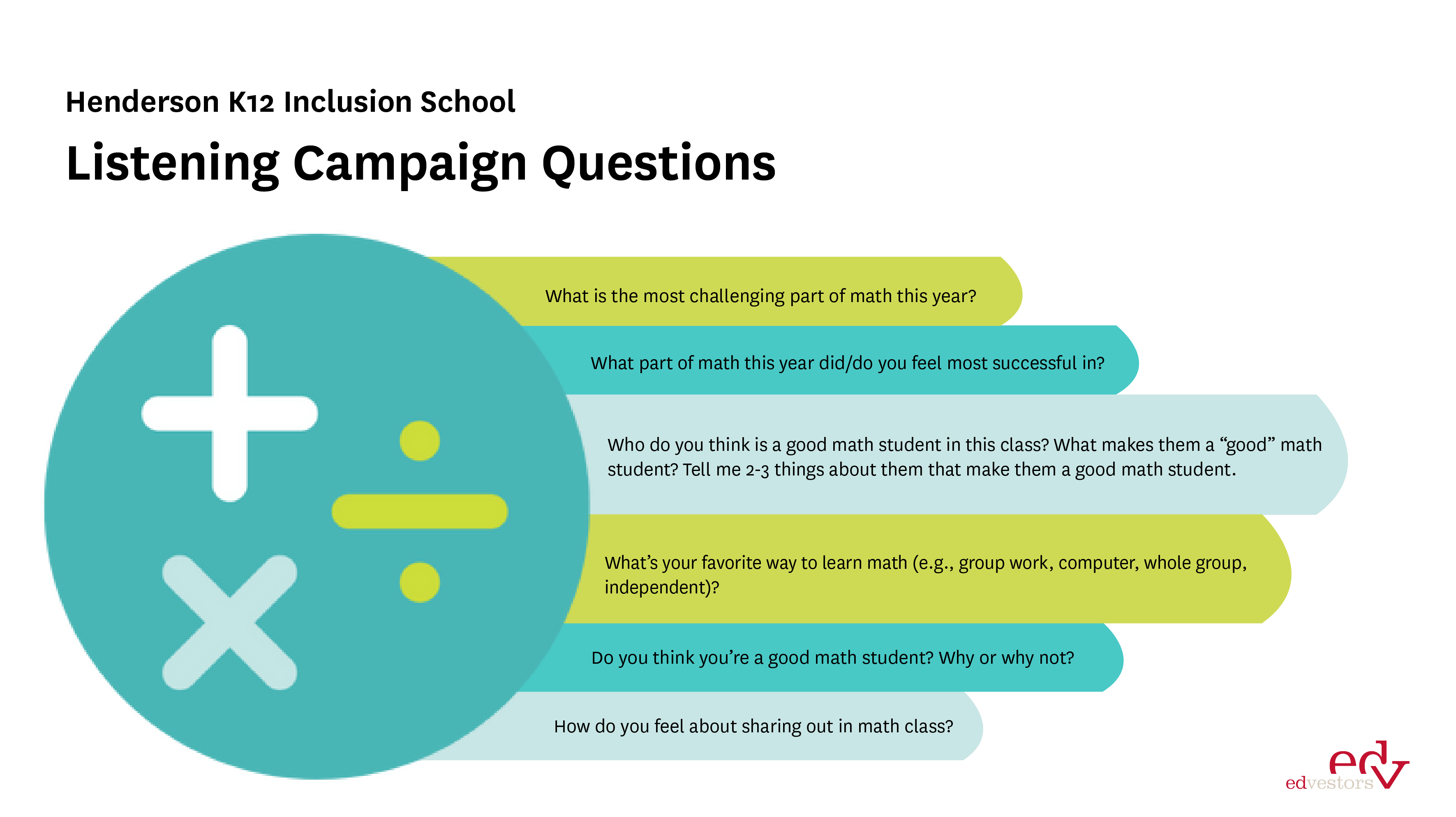Research & Insights / Students know best when it comes to student engagement in math
Students know best when it comes to student engagement in math

Mathematics education is a hot topic right now. Philanthropies like the Bill & Melinda Gates Foundation have made a commitment “to ensure students experience math as relevant, engaging, and rigorous” over the next decade. More locally, Massachusetts has joined the Launch Years Initiative, focused on designing high-quality and equitable mathematics pathways for students.
Among the areas of concern is student engagement in mathematics – its current state, likely causes of low levels, and strategies to increase it. How do students view mathematics, and themselves as mathematicians?
At EdVestors, we have spent more than a decade working alongside teachers, school leaders, district administrators, and external collaborators to improve mathematics education in Boston. We believe that mathematics identity and agency are critical components of student success. Several of our current grantees are examining key components of their mathematics education program through lenses of student identity and classroom culture, with powerful insights emerging to inform their work and our collective work.
One of those schools is the Henderson K12 Inclusion School. A team of eight mathematics educators from the Henderson has been engaged in a yearlong deep dive into advancing equity in their mathematics classrooms.
The Henderson team, which consists of general education and special education teachers across the elementary-to-secondary spectrum, started with data. They analyzed observation data from instructional rounds. They reflected on feedback from a recent round of classroom walkthroughs. They looked at CRIOP data and MAP test results, including changes over time. They reviewed results from the most recent school climate survey. They saw both bright spots and areas of growth.
Some key findings were that many students were hesitant to engage in deep student-to-student discourse, reluctant to take academic risks, and resistant to struggle.
Inspired by Street Data: A Next-Generation Model for Equity, Pedagogy, and School Transformation, they embarked on a journey to better understand the root causes of what they were seeing. Street Data challenges educators to engage in focused listening and observation, centering the voices of those on the margins of schools and systems. Instead of jumping to solutions, they got curious and recognized students as the experts on their own experiences.
The Henderson team focused on two questions: What are the root causes preventing students from taking academic risks in mathematics classrooms? Why are students not showing excitement for and deep engagement with their math work? To answer those questions, the team identified a group of students from grades 3-12 who struggled and/or regularly appeared disengaged in math class. Through a listening campaign, they explored a series of questions to better understand the beliefs, perspectives, and experiences of students.

Through their answers, students provided rich insights into the ways that mathematics classrooms do and do not engage and empower them.
Some of the themes were consistent across grade levels. For example, all students shared that they prefer sharing ideas in small groups rather than whole group discussions and they felt successful with strategy-based work like skip counting and using visuals. They also expressed an unequivocal and universal dislike of MCAS review.
Other themes varied by grade level. For example, answers to the question, “What makes a ‘good’ math student?” shifted notably over time. In the elementary grades, “good” students were able to do the work quickly and get the right answer. As students got older, the emphasis shifted away from knowing the answer toward knowing the questions to ask. In addition, this sample of struggling students seemed to lose confidence in their mathematics ability and identity as they moved through the grades, a common trajectory in schools across the country.
These reflections and insights from students sparked rich discussions across elementary, middle, and high school teachers that are shaping classroom- and school-based strategies. For example, teachers are working with different kinds of small group and large group formats that are responsive to what students shared, which varied greatly based on grade band. More broadly, the team is excited to deepen the collaborative work across the math team and with students.
This work takes time and patience, as changes in traditional outcomes are rarely immediate. More importantly, it takes a high degree of vulnerability and depends on a foundation of trust between educators and among educators and their students. The Henderson team shared the data back with the interviewed students and invited them to share their reactions and provide additional insights into their experiences, fears, and struggles. It is a critical and powerful tool to invite students into the meaning-making process, and we had a chance to see it in action on a visit.
The older Henderson students can give us inspiration for a path forward: perhaps being a “good” math educator is not about having all of the answers, but rather about knowing what questions to ask and asking them, inviting the students to show us the way.



